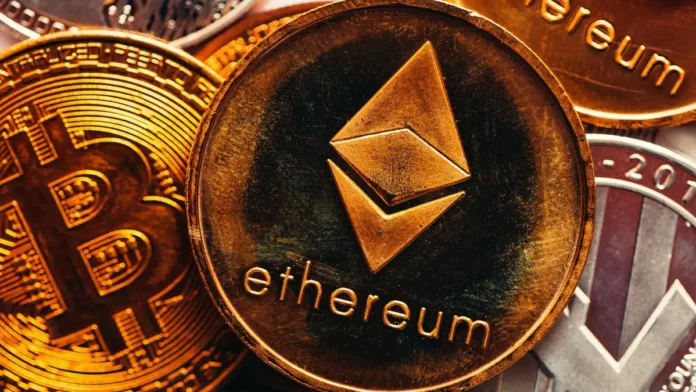
Ethereum is the technology behind Metaverse and innovations like NFTs, and is being used to create financial products that cut out third parties, such as banks and brokers. It also uses less energy than Bitcoin
A major contributor to the increased acceptance of cryptocurrency is the direct contact between users or parties. Leading name: Ethereum (ETH), which is the technology behind Metaverse and innovations such as non-fungible tokens (NFTs), is a leading name. Its network is being used to create financial products that reduce or even remove the need for third parties such as banks and brokers. Ethereum is currently second only to Bitcoin (BTC) in terms of market capitalization, with a market capitalization of around $404 billion as of March 29, according to data from coinmarketcap.com.Together, the two cryptocurrencies account for 60% of the cryptocurrency market.
How Is Ethereum Growing?
The Ethereum network comprises the token Ether. It was launched in 2015 when it was introduced in a white paper by its co-founder and programmer, Vitalik Buterin. Ethereum operates on blockchain technology, a public ledger that records all the account balances and transactions of a particular cryptocurrency. Ethereum plays a significant role in the development of Web3 as well.
After a turbulent 2018–19, Ethereum emerged in 2021 as the predominant smart contracting platform for decentralised finance and NFTs, US-based investment management firm ARK Investment Management LLC said in its 2022 report. According to ARK, ETH is the preferred collateral in DeFi as well as the unit of account in NFT marketplaces, suggesting that it is likely to capture a portion of the $123-trillion global money supply. It added that Ethereum could displace many traditional financial services, and Ether could compete as a global money system.
As financial services move on-chain, various decentralised networks are likely to grab share from existing financial intermediaries. The beneficiaries of this shift include Ethereum, the base protocol, and DeFi, the decentralised applications built on top of Ethereum, the report states.
“Ethereum has a lot of potential in the coming years as it continues to be a foundational part of DeFi apps.” Exposure to Ethereum technology is a potentially profitable addition to your investment portfolio, “says Bhagaban Behera, CEO and co-founder of Defy, a crypto platform. The Ethereum Mainnet is the most popular DeFi blockchain, with around 600 active DeFi protocols and a Total Value Locked (TVL) of over $100 billion.

High Potential
So, does Ethereum make for a good investment? Some experts believe that Ethereum is a good long-term investment, primarily for two reasons. “It is the largest altcoin in terms of market cap, and the adoption and use cases of the Ethereum blockchain are significantly higher than for any other blockchain network,” says Edul Patel, CEO and co-founder of Mudrex, a global algorithm-based crypto investment platform.
What Sets Ethereum Apart From Bitcoin?
Bitcoin is called Blockchain 1.0. It has transactions and limited automation of transactions. If you want to buy something from a seller using Bitcoin, for example, you could programme the transaction not as a direct payment but as a small script which automates (in such a way) that the payment is actually made after the good is received. Moreover, a third party has to be convinced that the buyer is happy and then do a signature along with the buyer (who already signed at the beginning). Only then does a seller get the Bitcoin, “says Sandeep Shukla, a professor of Computer Science and Engineering at IIT-Kanpur, co-director of the National Blockchain Project and co-director of software firm c3ihub.
The scripts are programmed in Bitcoin using a scripting language that can do only a few types of transaction process automation, while in Ethereum, the scripting language can do many kinds of transaction process automation and create programmable wallets, etc. These are called “smart contracts.” “This requires a virtual machine in every node so that the smart contracts (which are basically programs) can be executed. This is a big jump from Bitcoin’s direct transactions or limited programmed transactions. This is why Ethereum is Blockchain 2.0, “says Shukla.
However, because of this added capability and a language that is so general-purpose, smart contracts can have bugs, like any program. Also, due to concurrent transactions, the order in which transactions are executed, etc., there are many bugs. For example, in 2016, a decentralised autonomous organisation’s smart contract was hacked, exploiting a bug that allowed a cybercriminal to steal many millions of dollars’ worth of Ether. Since then, many attacks have taken place by exploiting bugs in smart contracts.

There are tools to test and verify the correctness of smart contracts, but they are not complete. As a result, even those tools cannot prevent users from making errors in smart contracts.Smart contracts, on the other hand, enable a plethora of new uses for blockchain technology that the Bitcoin blockchain, with its limited programming ability, cannot.
Shukla further notes that Bitcoin is dependent on “Proof of Work” consensus, and that means a lot of energy is used in maintaining the Bitcoin blockchain (1 percent of total energy usage in the world, according to Coinidol.com). But due to its limited programmability and without a substantial change in the Bitcoin blockchain’s programming model, we cannot have “Proof of Stake” there, he adds.
Ethereum is in the process of moving from “Proof of Work” to “Proof of Stake”. However, Proof of Stake in Ethereum kills decentralisation as 0.1 per cent of Ethereum users own 95 per cent of Ether. So, only 0.1 percent can actually determine the integrity and validity of transactions in Ethereum if Proof of Stake is used, “says Shukla.
However, this is a good thing, say some experts. According to them, “Proof of Work” is better as only a very small number of participants in the Bitcoin or Ethereum blockchain can mine due to the extensive amount of computational hardware and energy required to be a miner.



































